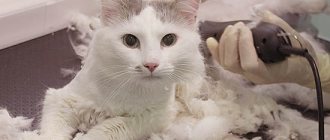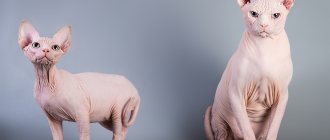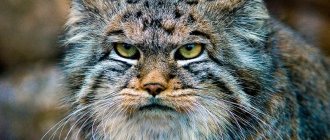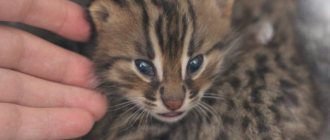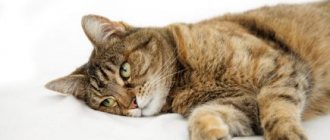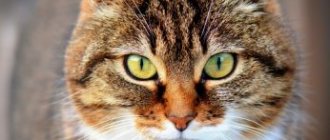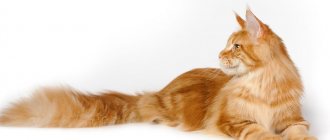Manul is the most cautious and slow representative of the cat family. It is also called the “Pallas cat”: a naturalist named Pallas first encountered the animal back in the 18th century. The attractive appearance and calm nature aroused the desire to domesticate the animal among many lovers of exotic pets. This is feasible, but there are some nuances: a cat is still better suited for living in the wild.
Homemade manul
Features of the Pallas's cat
A manul living in a person's house does not become an ordinary pet . Unlike some wild cats, such as caracals and servals, which are completely domesticated, the Pallas's cat always remains wild, even if it begins to trust its owner. Because of this, if the cat decides that he is in danger, he will defend himself against the person who raised him, causing serious damage to him with teeth and claws that are much longer and stronger than those that domestic cats have.
It is generally accepted that a wild animal, if taken into a home as a child, gets used to its owner and after a certain time becomes completely tame. This statement does not apply to Pallas's cat. It is impossible to predict what kind of domestic cat the manul will grow up to be. Even if a wild kitten was given to be raised by a domestic cat, which raises it along with its kittens, you cannot be sure that, having matured, the Pallas's cat will not seek solitude, hiding from humans and the other cats with whom it grew up.
At the same time, there are also individuals who, growing up in a house, become devoted to their owner and maintain a close connection with them throughout their lives. Such cases are rare, and therefore, when deciding to have a Pallas's cat in your home, you should not rely on such exceptions in the domestication of a wild cat.
When deciding to keep a Pallas's cat, you need to take into account that, most likely, the animal will remain wild, although not aggressive. The Pallas' cat's behavior towards others at home will retain a character similar to its habits in the wild. The pet will try with all its might to minimize contact with humans, hiding in secluded places.
It is also important to remember that a cat needs a large area for walking. Due to the fact that the Pallas cat can easily leave the house and is not attached to it, for walks it is optimal to arrange and equip a cat enclosure, which will contain :
- house,
- lounge chairs,
- climbing structures,
- drinking bowl,
- feeder
If desired, it is possible to keep the Pallas's cat in an enclosure all year round. Animals tolerate low temperatures well when there is good shelter. To do this, you will need to properly insulate the cat’s house so that even in severe frost the animal feels comfortable.
Interesting Facts
Instead of such a pet, it is better for a person to get a British one, which has a soft and flexible character.
Japanese scientists tried to cross a Pallas cat with a domestic cat, and they managed to get a hybrid. But the animal still inherited a tough, nasty, quarrelsome character. In the natural environment, there are also cases when a male Pallas cat covers an ordinary cat. Owners of such animals note that the offspring have a predominant appearance, character and habits of wild cats. Therefore, if you want to have a feline pet at home, it is better to take a closer look at other breeds that are more delicate, kind, easy-going, and loyal. These varieties include:
- Maine Coon;
- British and Scottish;
- Siberian;
- Burmese;
- Kurilian bobtail.
Difficulties of home maintenance
Keeping wild cats as pets is not easy and is not always justified. Having decided to have a Pallas's cat at home, you need to be prepared for a number of difficulties that will arise in such a neighborhood. This wild cat is self-sufficient, and therefore it does not need people or other animals at all, with the exception of rodents, which the Pallas's cat loves to hunt. Manul is not the affectionate domestic cat that everyone is used to; and he will not sit on his lap, enjoying communication with his master. Keeping Pallas cats at home is associated with serious problems .
- Aggressive behavior towards children if they become overly persistent in pestering the animal, imposing their communication on it and especially trying to remove it from the chosen den. These are not your typical domestic cats.
- Damage to everything around. Pallas' cats are similar to teenage puppies, who tend to damage furniture and shoes by chewing them. The cat will happily try many things, and will also constantly scratch furniture, walls, curtains and even linoleum. Due to the special strength of the teeth and paws, the damage caused by a Pallas's cat living at home is very significant. Having settled an animal, you need to remove expensive things from its access area. Pallas' cats are not domestic cats that respect their owner.
- Treatment problems. Due to the behavior of a wild cat, if it has health problems, you may not immediately pay attention to them. Also, due to the fact that the animal is wary of people, it will be quite difficult for a veterinarian to examine it properly. An additional problem will be the fact that there are few specialists who know the characteristics of these animals. Therefore, treatment for Pallas cats will most likely be carried out in a similar way to what domestic cats receive, but this is not true.
- Constant shedding. The manul has particularly thick hair up to 7 cm long. The cat sheds very rapidly in the autumn and spring. During the rest of the year, the Pallas' cat's fur is actively replaced, and therefore shreds of it will always be present in the apartment. In order to reduce the contamination of your apartment with fur, you need to regularly brush your exotic pet, which is extremely difficult if it is too wild. Domestic cats shed 2 times a year.
- Hunting instinct. The cat is strong and perfectly adapted for hunting not only small rodents, but also marmots, which is why it can pose a danger to small pets, including puppies and small breed dogs, which the pet may decide to feast on as if it were fresh game. .
Appearance of the Pallas's cat
The Pallas's cat is very similar in size to an ordinary domestic cat, and although it seems much larger than a cat, this is only because of its thick and long (up to seven centimeters) fur. The standard size of the body length of the Pallas's cat is within 65 cm, and the weight can reach only 5 kg. The coat color of this predator is light gray interspersed with white or yellowish color. Looking at it, it seems that it is covered with snow, and this is an ideal camouflage in the wild. The manul also differs from the domestic cat in its wide
flat head, as well as small, widely spaced ears. The pupils, unlike the pupils of a domestic cat, even in bright light do not take on a slit-like appearance, but remain constantly round. The lifespan of Pallas's cat in captivity is 11 or 12 years, but in the wild it is unknown how many years they live. Pallas' cats are found in the wild in Transcaucasia, Asia, Mongolia and China. This species of cat is on the verge of extinction, but since they have a very secretive nature, it is not possible to calculate the exact number of Pallas' cats in nature.
Pallas' cats are unpretentious, so they easily adapt to life in the zoo, however, as for reproduction, it is worse in captivity than in the wild. And those kittens that are born within the walls of the zoo do not have very good immunity and are susceptible to various infections that are fatal to them.
Possible difficulties and illnesses
In the process of keeping Pallas's cat in captivity, problems may arise with treating the animal, since very few veterinarians are familiar with the characteristics and diseases of the species, and methods for domestic cats are not always applicable to it. In addition, the mustachioed-striped one simply will not let anyone near him, even at moments when he is unwell.
Of the most dangerous infections that are typical for this furry animal, the most likely is toxoplasmosis.
Wild cat lifestyle
The Pallas's cat's habitat is in areas where low temperatures and a generally harsh climate, without much snow, prevail. He chooses mountainous semi-desert areas for housing, and may even be in mountains reaching a height of 4 km. The abundance of shrubs also applies to the preferences of the Pallas's cat. It almost never changes its favorite places; it settles in an abandoned badger or fox hole. Leads a twilight and nocturnal lifestyle, hunting strictly at this time. Pallas's cat cannot be called fast and dexterous; on the contrary, he is clumsy and slow. When he hides from enemies or hunts prey, he hides on a rock and waits. It is almost impossible to notice it, since thanks to its color it merges with the mountain nature.
The hunting of the Pallas's cat consists in the fact that it guards its prey at its hole, and when it hides and sits in ambush among the stones, it patiently waits for the appearance of a rodent. It happens that he comes across a baby marmot, a gopher, and also a hare. When problems with food arise and it becomes scarce, the manul begins to eat insects.
Pallas's cat's lifestyle, nutrition and reproduction
- This wild animal, as already mentioned, lives in places with a harsh climate and low temperatures. By the way, cats predominate in places where there is not much snow. really likes places with an abundance of bushes , as well as semi-desert mountain areas. It can climb mountains to a height of up to 4000 meters. Lives in strictly defined places, rarely changing its favorite places. It makes its home in old fox or badger holes, where it sleeps all day. It goes hunting at night, or rather at dusk and early in the morning. Manul is considered the slowest and clumsiest cat. When catching prey or hiding from an enemy, the Pallas's cat prefers to lie low and hide on the rocks. Its coloring helps it blend in with its surroundings.
- The Pallas's cat gets food by guarding the minks. Hiding among the stones, he waits in ambush for a pika or other rodent to appear. Sometimes gophers, baby marmots and even hares can be caught as prey. When its traditional food (due to some circumstances) becomes scarce, the Pallas cat calmly switches to feeding on insects.
- Once a year, around February or March, the Pallas' cat's mating season begins. The female carries the kittens for two months and in early May they are born . Usually there are no more than six kittens. Newborn Pallas' cat cubs weigh about 300 grams and are 12 centimeters tall.
Interesting: Should you be afraid of the cross spider, its appearance, bites and poison?
Kittens, like all cats, are born blind and begin to see after 10-12 days. After three to four months they begin to hunt. At the age of 10 months, little Pallas' cats reach sexual maturity.
Is it possible to keep him at home?
Unlike its relatives, the Pallas's cat cannot be domesticated due to its indomitable nature. It is believed that if any animal is taken home when it is still a small kitten, it can grow up tame, with behavior no different from a domestic cat. But this is not about the manula. There are no guarantees that it will take root. Even if he is raised by a domestic cat along with his kittens, the manul will not be able to love them, and when he grows up, he will be aloof both from his half-sisters and brothers, and from people whom he has known since childhood. You need to know about this in advance before the manul appears within the walls of the house in order to make a decision for yourself whether such a wayward pet will suit you.
Manul at home
In the zoo, as mentioned above, the Pallas's cat can easily live and even reproduce. This is due to the fact that there it is much easier to create conditions for him as close as possible to his habitat in the wild. The Pallas's cat has become so alienated precisely because it lives in areas with very small populations. And in a zoo, being in his enclosure, he will feel at home. Today you can find one and a half hundred Pallas' cat cats in 50 zoos around the world.
But with Pallas's cats within the walls of a house or apartment, everything is much more complicated. As you know, some breeds of domestic cats can constantly hide somewhere and protect their shelter from people trying to get into it. Manul will behave the same way - he will
to staunchly defend the place allocated for him for housing. Although by nature it is not an aggressive predator, in this case it is quite capable of attacking a person. And his teeth and claws are sharper than those of any domestic cat.
If the Pallas's cat gets sick, then, since he does not allow anyone near him due to his unsociability, it will be problematic to examine him in order to diagnose the disease and treat him. Pallas' cat breeding in apartment conditions, unlike keeping in zoos, will also face great difficulties.
Character traits and level of intelligence
Among the main characteristics of the Pallas's cat, several basic ones that are unique to him should be highlighted.
Zoologists studying Pallas's cat in the wild have noted its secrecy. Cats almost always live alone and try not to give away the location of their den. In winter, the Pallas's cat will never walk on untrodden snow. The cat will wait until other animals leave chains of tracks, and then he will make his way home along them.
The Pallas's cat lives in one place, which represents his hunting grounds. He cannot stand the appearance of other cats and lives secluded and lonely. During the day it sleeps in its den and hunts at night or at dusk. Only in summer can a cat get out to a secluded place to bask in the sun.
The Pallas's cat is very leisurely, never fusses and does not try to catch up with anyone over long distances. The fur coat gives the Pallas cat a clumsy appearance, but, like any wild animal, his reaction is immediate. Seeing danger, a cat can freeze in place, merging with the landscape, run away into the bushes, or climb high up a mountain.
In the wild, cats hunt mice, pikas, birds, and insects. Pallas's cat can also catch larger game - a marmot or a hare. Most often, the cat waits for prey in ambush or in the immediate vicinity of its burrow.
The cat does not know how to purr; the sounds it makes are similar to growling, hissing or snorting.
Problems created by manul at home
The Pallas's cat is such an unsociable representative of felines that it would hardly have noticed the disappearance of animals and humans from the face of the earth. That is why people who decide to place this predator in their home should think carefully. Some, despite possible difficulties or due to a simple misunderstanding, still decide to get a Pallas's cat. In this case, they risk encountering the following problems:
- As mentioned above, this wild animal will constantly hide from its owner and avoid him, so it is unlikely that he will be able to enjoy communication with him.
- Dog owners are well aware of their behavior in terms of the fact that dogs at a young age spoil everything in the apartment. The same thing will happen with a Pallas's cat that finds itself in a home environment - it will damage wallpaper, furniture, curtains and other items.
- A sick Pallas's cat cannot be cured at home, and in veterinary clinics not every specialist knows this animal and the diseases to which it is susceptible so well, so there is a high risk that the Pallas's cat will be treated like an ordinary domestic cat.
- The long seven-centimeter fur of the Pallas's cat can become another problem. He sheds heavily and almost always. Shreds of wool will fly throughout the apartment. And in order to reduce their number, the manula will need to be combed.
Knowing about all the difficulties of keeping a manula at home, you should not rely only on your desire. There are cases when people, succumbing to an impulse, settled these predators in their homes, but very quickly realized that they could not tame it after all, and brought it to the zoo. But we can say with confidence that keeping a Pallas's cat at home is not recommended for two reasons: firstly, it can cause damage not only to a person's home, but also to himself, and secondly, the Pallas's cat is already on the verge of extinction, that's why keeping him in captivity is considered a very irresponsible act.
The Pallas cat has a charismatic, brutal appearance: small size, small ears, huge green eyes, long fur, strong body structure, luxurious tail.
This makes him a desirable pet among lovers of exotic pets. Is it worth keeping a wild cat at home and is it even possible?
Appearance of the breed
Pallas' cats are large and fluffy cats with a powerful, muscular and strong physique:
- The head is medium in size, wide in shape, with small ears, slightly rounded at the ends, placed on it, like toy ears. Flattened muzzle, fluffy and long hair on the cheeks.
- The eyes are amber in color, slightly convex. The pupils do not react to color. This phenomenon is observed in most representatives of the cat world.
- The legs are short, but this is compensated by their power and muscularity.
- The tail is medium in length, very fluffy.
- Color – gray with white tips. The body is mottled with black stripes that stretch from the tail across the entire rump and across the body. There are dark stripes on the cheeks as well.
The size of the animal, despite its external massiveness, is quite compact. The weight of an adult is 2-5 kg. Compared to other powerful breeds, for example, the Maine Coon or the Norwegian forest cat, the Pallas cat is significantly inferior in size. The largeness and dimensions of the appearance are given by very fluffy wool.
Domestic manul: is it possible to keep it in an apartment?
The Pallas' cat looks as if he skipped about 12 million years of evolution and somehow, incredibly, got from the era of dinosaurs, saber-toothed tigers and pterodactyls into the modern world. Natural habitat - India, Pakistan, Siberia, steppes of Mongolia.
It feeds on rodents, birds, lizards, insects, baby hares and other small animals. Otocolobus manul or Palass's cat, belonging to the cat family, is on the verge of extinction. Having such a pet at home is an attractive idea.
In practice, an animal, even adopted by a small kitten, will never become completely domestic and tame. It is possible to keep it in an apartment or a private house, understanding the characteristics of the species, accepting difficulties, and not expecting unusual behavior from the animal.
Habitat
The optimal living conditions for the furry representative of the cat world are light snow, moderate cold temperatures and a steppe with tall grass. The cat will feel comfortable even among rocky and mountainous terrain. The main thing is that the rocks and mountains have many exits.
The animal's body is not affected by severe cold. Pallas cats have strong immunity and are not prone to any diseases. The habitat of cats includes Transbaikalia and Central Asia, Mongolia, Afghanistan and Transcaucasia, the western part of China.
Manul at home
The Manul will never behave like an ordinary domestic cat. He will avoid contact with people and other pets in every possible way. Hunting season will be announced for small animals and poultry. Small breed dogs, kittens, and puppies fall into the category of potential game. His freedom-loving nature does not need the company of strangers or relatives.
Planning to breed steppe cats at home is a disastrous idea. The male and female will be in a state of constant competition for the best secluded places and territories. Offspring will be at the very bottom of the couple's list of interests.
Even in zoos, where Pallas cats are provided with favorable conditions for breeding, it is rarely possible to wait for offspring. If a miracle happens, kittens often die, and adults also become victims of infections. What can we say about home maintenance? Pallas cats are under state protection as a species listed in the Red Book. It is not possible to legally purchase a kitten.
Is it possible to tame a manula?
There are cases when Pallas' cat babies were fed by a domestic cat, but as they grew up, the adoptees did not adopt her behavior, remaining independent and aloof.
Domestication is a matter of luck, not technology. Rarely, there are individuals that are loyal to people and do not try to hide when the owner approaches. In any case, playing with him, stroking a pet lying on your lap is not about the Pallas's cat.
Manul at home: pros and cons
One of the advantages is that the animal does not require the owner’s attention, and the latter’s ego will be stroked by the rare pet. Otherwise, exotic will bring more problems than pleasure. It is strictly not recommended to have it in an apartment where children live. The predator will not tolerate intrusiveness, familiar treatment, attempts at advances, and the child will receive injuries from its claws and teeth.
Characteristics and behavior complicate treatment if the animal gets sick. Because of the Pallas' love for solitude, it is difficult for the owner to notice in time that the ward is behaving strangely, experiencing pain, and discomfort. Transportation to the clinic and a full examination by a veterinarian will turn into a quest.
It will be difficult to find a doctor who is familiar with the peculiarities of somatic diseases and infections in Pallas cats, who understands how and how to treat them. Most likely, the doctor uses techniques suitable for domestic cats, and this will lead to complications and the potential death of the wild animal.
Price
Such a rare exotic animal will not be cheap. Prices start at $4,000: it’s not uncommon to find examples that sell for four zeros. The cost is influenced by the region in which the predator was caught. There are three of them: Siberia, Central Asia and China.
- The Siberian or common species lives in Mongolia, Siberia and Northwestern China. It is light gray in color and has thicker fur than other species.
Siberian manul - The Trans-Caspian manul is distributed in the area from the Caspian Sea to Pakistan. The steppe cat is characterized by a ginger tint and reddish stripes, which makes it inconspicuous in the brown-yellow landscapes of Afghanistan, Iran and Turkmenistan.
- The Tibetan Pallas' cat lives in the barren mountains of Kashmir, Nepal and Chinese Tibet. This inhabitant of mountain gorges has a darker color, which in winter gives way to silver.
Tibetan Pallas's cat
Depending on the number of borders and customs, the cost of an exotic cat changes. For 4-6 thousand dollars you can buy a steppe species from Kazakhstan or Uzbekistan. But the Pallas's cat brought from Tibet will be sold at the price of an inexpensive car.
Unfortunately, this wonderful feline is dying out. Poaching, herding dogs, extermination for the sake of thick fur - all these factors lead to a rapid reduction in the number of Pallas's cats. And although much is being done to preserve the population: Russia, Mongolia, Kyrgyzstan, China and a number of other countries have included the animal in the Red Book, the problem remains.
Watch also the video on the topic:
Manul at home: possible problems
Domestic cats shed seasonally: in spring and autumn. During these periods, the Pallas's cat also renews its coat. The rest of the time, his long (up to 7 cm) coat and thick undercoat come out in clumps. To avoid “hair growth” on the furniture, carpets will have to comb the pet daily, who will avoid the procedure in every possible way and offer active resistance.
The manul is similar in behavior to a grown-up puppy; he actively chews everything he finds attractive, gnawing shoes, table legs, sofas to splinters and small pieces.
Do not mind sharpening its claws on upholstered furniture, walls, laminate flooring, doors, leaving deep furrows. The strength of the manula's jaws and paws is superior to its domesticated relatives, and the damage will be much greater. It is useless to punish and educate a palassa cat.
Nuances of keeping a manul
The only possible option for keeping a wild cat at home is in an enclosure. There he will feel relatively comfortable, a hole where he can retire and a piece of personal space for walking and lying in the sun. It is good to equip the enclosure with thick driftwood, on which the animal can climb and sharpen its claws on them.
Pallas' cats are fed fresh, pre-frozen meat, and given milk, kefir, and eggs. Sometimes chopped offal can be mixed with steamed buckwheat, rice, and vegetables. Traditional commercial cat food is not suitable for them.
Why can't you tame the Pallas's cat?
It took humanity millions of years to domesticate the wild ancestors of the modern cat; gradually, naturally, the most sociable, good-natured individuals remained near people. Manul is a child of the wild, living in freedom. Like any free animal, natural conditions are close to him, where he is the master of the territory, hunting, swimming according to his own rules, without needing the patronage or tutelage of the owner.
Keeping a Pallas's cat at home is a wrong decision. For a wild cat, life in captivity will be dreary and joyless. They cannot be castrated or sterilized; the operation will lead to hormonal imbalances.
A person will receive as a pet an untamed animal that avoids contact with the owner, household members, and is capable of injuring children and other pets. There are a sufficient number of cat breeds, including rare, expensive ones, ready to become companions and loyal friends of the family, a source of pride and prestige.


